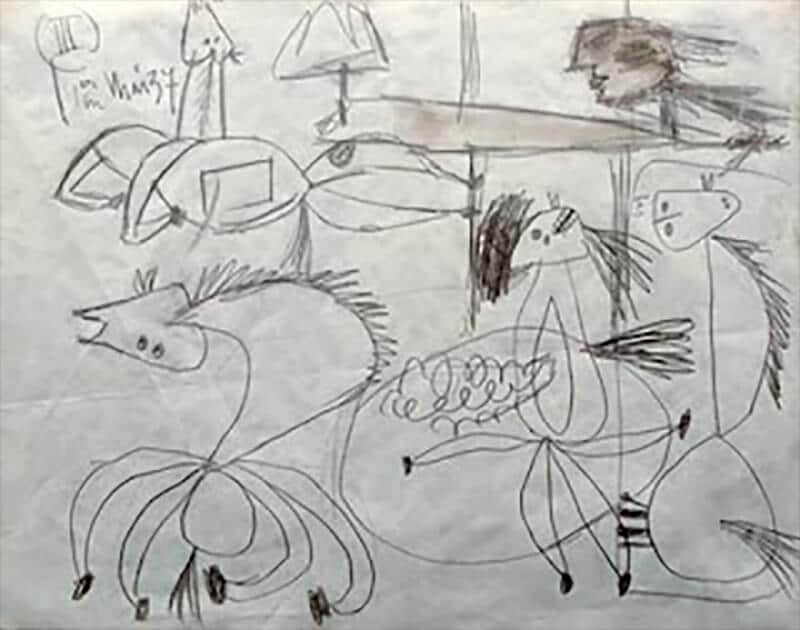
It seems impossible now that an institution like the Museum of Modern Art would lend, say,Les Demoiselles d’Avignon or The Red Studio at all, let alone to a small public art gallery in the east end of London. But that’s pretty much what happened in 1939, when Picasso’s hugeGuernica (painted in 1937) was loaned by MoMA, after pertinacious efforts by the Communist Stepney Trade Union Council, to the Whitechapel Art Gallery in order to raise public awareness of and garner sympathy for the Republican effort in the Spanish Civil War. That apainting—and a painting that takes tragedy as its general subject, owing as much to Poussin or Rubens as anything from contemporary life—was thought to have sufficient persuasive punch to drive the message home is the stuff of an agitprop daydream (imagine that happening now!). The thing is, though, Guernica isn’t only a painting. It’s a Picasso, and the logistics of the loan itself were impressive enough to embolden the gallery’s message. Although the Whitechapel was (and remains) free to enter, the admission charge in 1939 was a pair of workman’s boots, at Picasso’s suggestion, which the gallery lined up in ranks in front of the painting as a gesture of solidarity, like a phantom army. At the end of the exhibition, the boots (a couple of hundred pairs) were then sent to the Republican fighters in Spain. The painting went back to New York, and eventually to Spain, where it is now.
Now, as part of the redesign and expansion of the Whitechapel, Goshka Macuga (nominated for the Turner Prize last year) has brought Guernica back…sort of. In 1955, Nelson Rockefeller purchased Jacqueline de la Baume Dürrbach’s tapestry of the painting, made in collaboration with Picasso. On Rockefeller’s death in 1985, the tapestry was loaned to the United Nations building by his widow, where it still hangs outside the UN Security Council. That tapestry has returned to the Whitechapel for the duration of Macuga’s installation, where it’s been placed among archived materials pertaining not only to the original loan of the painting and the history of far-left activism in the east end, but also to the current loan of the tapestry andrecent protest events around the G20 summit in London.
The “sort of” is important, though. Just as it’s sort of Guernica—and there’s a combination of amazement and disappointment at seeing the tapestry, which becomes a sad reminder of what it isn’t—the installation is sort of political. Macuga’s installation has a compelling melancholy to it, not just in its hesitance to complement the screaming rawness of Picasso’s painting (the very fact that it’s the tapestry, rather than the original, plants a pair of quotation marks around the image), but in its reminder of a gentler, more honest, more optimistic age, when apple-cheeked Dickensian Communists in Les Mis rags lined up with boots in hand to learn about the badness of war (many of whom would have fought in World War I, and wouldn’t need that spelled out for them). And there is something of the smugness of the art establishment behind Guernica‘s history. When the tapestry was covered over with a blue curtain while Colin Powell made the case for weapons of mass destruction, the art world couldn’t stop congratulating itself for having the guts to declare that war is horrible, no matter what The Man says (It’s been said that the blue curtain was hung there for ease of translation to a TV screen; whatever the reason, announcing anything in front of Guernicawould be like reciting Wordsworth at a Slayer gig anyway).
Macuga’s installation centers around the afterlife of Guernica in the political imagination. Draping a blue curtain behind the tapestry and displaying photographs and press clippings about “the case for war” in the circular table in the middle of the room makes that association clear. A bronze statue of Powell “by” Macuga (the press release says it’s “by” her, but the wall text claims it’s “modelled” by someone else, which I think means “made”) apparently “in Picasso’s cubist style” (but really more Paolozzi than Picasso) is an unnecessary sight gag, drawing parallels between pictorial and actual destruction.
Macuga limns the aesthetic of political spaces, setting up the room much like a council chamber and encouraging (in an open letter to visitors) the organization and documentation of political meetings and discussions in the room. You can’t help wondering what those meetings might be like, or whether they’d be able to have a serious discussion without those contemporary art quotation marks hovering around like giant wasps. Seventy years on, things just aren’t the same, and the inclusion of flyers from the recent G20 demonstrations, one of which depicts the effigy of a banker being hanged from a lamppost under the legend “Enough is Enough!” draws uncomfortable parallels with Picasso’s vision of bodily desecration. Macuga’s installation explores the “feminization” of a very masculine (even macho) art-historical trope—the cinema-screen-sized vision of epic annihilation, epitomized by Gericault’s Raft of the Medusa (which also, interestingly, came to London “on tour” in 1820, and was shown in full-scale reproduction at Tate Britain a few years ago)—through the careful teasing away at the layers of meaning and resonance. Less than a year after Guernica was shown at the Whitechapel, in August 1940, Nazi bombing raids destroyed large areas of east London, killing hundreds and forcing mass evacuations out of the city. It’s hard not to see the tapestry in the light of that, or to imagine of those empty boots, lined up, without thinking of the stacks of discarded shoes and clothes from the concentration camps. Ultimately, it’s hard not to see Guernica, wherever you look.